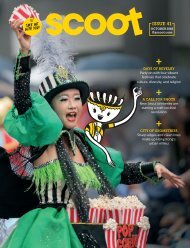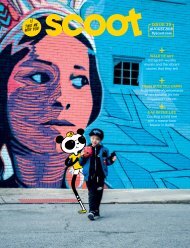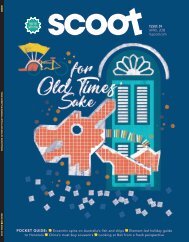July 2018 - Scoot In-flight Magazine
Create successful ePaper yourself
Turn your PDF publications into a flip-book with our unique Google optimized e-Paper software.
CEBU<br />
EAT’S A DATE<br />
Tourists, locals, and expats<br />
flock to Sugbo Mercado for<br />
a one-of-a-kind dining<br />
experience. Aside from the<br />
variety of local cuisine<br />
available like the<br />
ubiquitous lechon<br />
(roasted suckling pig), this<br />
weekend food market<br />
features artisanal dishes<br />
from fledgeling<br />
entrepreneurs. Experience<br />
being serenaded by a live<br />
acoustic band while you<br />
eat. Or better yet, march<br />
up on stage and jam with<br />
featured performers!<br />
sugbomercado.com<br />
Spaniards.<br />
The house’s<br />
coral stone<br />
walls and red<br />
terracotta roof<br />
are glaring marks<br />
of Spanish<br />
architecture.<br />
“My father was kind of<br />
in love with this house,<br />
maybe I inherited this love from<br />
him,” Jaime added.<br />
No one in their family knew how<br />
famous the 1730 Jesuit House was<br />
until Jaime accidentally saw a<br />
picture of it in one of the books<br />
found inside a library at Ateneo<br />
de Manila University. Then a<br />
college student taking up<br />
Business Management, he began<br />
to understand that their property<br />
is one of the country’s historical<br />
gems. But it was only around ten<br />
years ago that he became<br />
passionate about history and<br />
heritage; his schoolmate Roberto<br />
Aboitiz encouraged him to open<br />
the house to the public.<br />
LOOKING TO<br />
THE FUTURE<br />
Now, the 1730 Jesuit House is still<br />
intact and functional, although<br />
no one lives there anymore. <strong>In</strong><br />
fact, the dining area is often used<br />
by special guests for museum<br />
functions. Visitors are given<br />
access to most spaces of the<br />
house like the kitchen and<br />
bedrooms, among others.<br />
To further conserve and<br />
protect the house, some areas<br />
are currently undergoing<br />
restoration, an undertaking made<br />
possible with the help of Escuela<br />
Taller de Filipinas, a foundation<br />
dedicated to heritage<br />
preservation. Last year’s<br />
excavations allowed<br />
management to unearth some<br />
significant pre-colonial items like<br />
coins and housewares. Members<br />
of the academe, heritage<br />
conservationists, and experts<br />
also actively help in maintaining<br />
the house, especially now that<br />
more people are coming to see it.<br />
ABOVE:<br />
The ceiling<br />
shows the<br />
house’s intricate<br />
details like the<br />
dragon tail,<br />
Chinese clouds,<br />
and the<br />
terracotta roof.<br />
CIRCLE:<br />
A cafe where<br />
visitors can enjoy<br />
a cup of coffee or<br />
read various<br />
books donated<br />
by the nowdefunct<br />
local<br />
bookstore, Pages.<br />
SCOOT<br />
51










